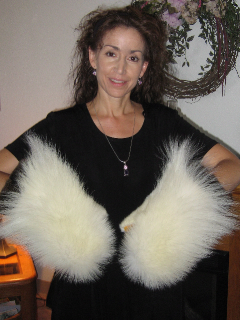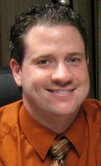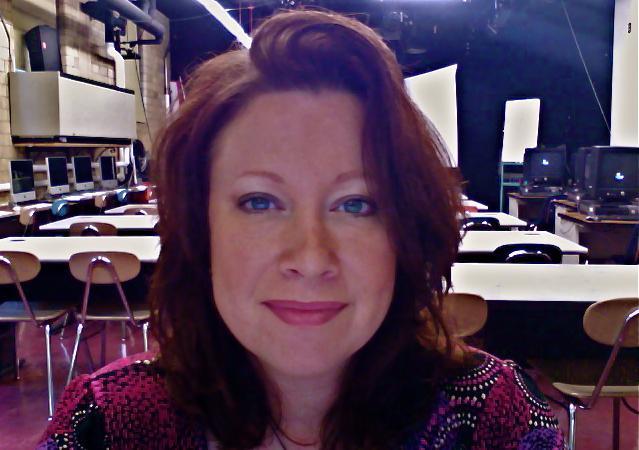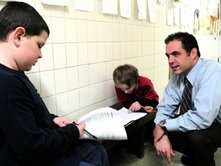Leaders of the Year Winners 2008

Since 1985, Tech & Learning has recognized professionals in the field who exemplify what it means to be an ed tech leader. Every year, this decision gets more difficult. Over 150 applicants crammed our inbox this time around with stories of amazing achievement plus actual
data that proved it.
Each of the four educators profiled on the next pages show how to use technologies to a greater effect in classrooms. But what made them winners is more than their good tech practices. They also were able inspire others—the bosses, the school board, the parents, the
community—to literally and figuratively buy into their projects. They also continue to show dexterity in maintaining their efforts over the long haul. All four were honored in November at the National School Board Association’s T+L conference in Seattle, WA.
—Kevin Hogan
Achievements in Alaska
SHANA BLANKENSHIP
Director of Instructional
Support, North Slope Borough
School District (AK)

What does a child who faces a 67-day-long-sunset, stray polar bears wandering through town, lack of household electricity and running water, and a reality where whaling is a financial necessity have in common with a NYC student? Since Shana Blankenship and her dedicated support team launched their 1:1 program, a whole lot more.
Overseeing a district-wide computer program designed to put an Apple laptop into the hands of every 5th-12th grader demands enormous time and energy resources, even in the best of circumstances. When your “district” covers 89,000 square miles (the size of Minnesota) and a simple tech call involves flying by small aircraft for hours over the frozen Alaskan North Slopes, the size of the task becomes Herculean.
Blankenship took on that position out of frustration with the district’s devastating teacher turnover (40%) and poor graduation rates (50%).
Tools and ideas to transform education. Sign up below.
“The school board had a vision for their children to have equity in their education,” says Blankenship, “and that included access to technology.”
“It was a daunting process. We receive our internet via satellite. Something as simple as a sunspot can throw the whole system off. We had 1800 computers to deliver to remote villages accessible only by small aircraft. Once, a very caring maintenance man saw 25 computers sitting on a 40 below runway too long and took the initiative to bring them back in.”
Blankenship credits that comprehensive level of dedication and compassion to overcoming difficulties like cross-training teachers to program their own servers from thousands of miles away and broken laptops that can necessitate someone to hop on a plane to address the problem.
Massive logistical complications aside, the idea of widespread cyber connection had other challenges. In a resistant culture with concerns that the introduction of mainstream Western culture threatened the traditions and customs of generations of proud Inupiaq Eskimo Indians, selling the plan needed a delicate touch.
Blankenship and her team incorporated the culture into the program, integrating Inupiaq ways into day-to-day lesson plans and offering students a multimedia opportunity to explore their people and share with others what it meant to be Inupiaq.
Fortunately, not only did the community, formerly apathetic toward school involvement, put forth the effort required to join, 100% of parents or guardians arrived at the school to accept responsibility for the laptop. Continued interest has bridged a gap between the generations, creating a motivation for elders to stay on par with quick minded students.
“Our kids are dubbed the tidal wave,” Blankenship says, “because we simply can’t keep up with them.”
As one early sign of success, the first six week period of school saw 11,157 tardies. Post-1:1 launch, the numbers dropped dramatically to 2,787 for a similar six-week-period. Hopes that reignited student enthusiasm about studies and attendance translate to greater teacher satisfaction and lower turnover will be seen as the program progresses.
“We used technology as a carrot,” said Blankenship, “and it worked.”
Putting Good Ideas to Work
JOHN DAVID SON
Chief Information Officer,
Marshall County
Public Schools (KY)

Not many people can say their computers cure cancer. John David Son hopes that just might happen thanks to participation
in the Kentucky Dataseam Initiative.
Son’s district, in conjunction with other participating schools throughout Kentucky, have partnered with the University of Louisville’s (U of L) Brown Cancer Research Center, as a part of the Dataseam Initiative, to form a techno-grid across the state. While students play at recess, go home for the night, or hit the beach on vacation, their computers stay hard at work computing processes and conducting theory research towards finding a cure for the devastating disease.
The win-win situation offered Son the ability to enhance his formerly 100% PC district with 60 U of L compatible iMacs. Son also proudly acts as support to two paperless classrooms within his district, achieved through the hard work of the teachers in gaining community
donations to help fund the transfer from traditional methods.
Son notes a tangible enthusiasm and heightened engagement from the fourth graders, when observing the classes.
“[This has] really taken learning to a new level. They’ve challenged their kids to think outside the box, to collaborate, to communicate,
and to really become digital and twenty-first century learners. This is a skill that even at a young age is really going to prepare these kids
for life and what we will see in global society, especially by the time they graduate high school and go into college or the workforce.”
Son then went an environmental and financial smart step further with the Technology Takeout program. Using the district’s stockpile of older, outdated computers and hardware, the program took recycling to a new level with the assistance of high school students attending the district’s IT center.
These students gained hands-on experience revamping and upgrading the older computers to make them useable with
new educational software. The school then partnered with family resource centers that help the district’s lower-income families within the district, to place the reconditioned computers into the hands of students who were not afforded the luxury of owning a computer in their homes.
To offer an inclusive broad range of opportunities, the district offers free community technology classes to enhance involvement.
“We target a wide audience. Beginner courses— we say ‘for people who are afraid to turn a computer on,’— to offer basic skills and
knowledge so the technology is not something to be feared, all the way up to intermediate and advanced photography classes.”
The key to this success connects family and community with the natural love children have for technology.
A New MediumWell Done
LAURA BARSTOW
TV/Video Production
Teacher, Rochester City
School District (NY)Athletes and “brainiacs” aside, Laura Barstow worried that in a district struggling against a 75% poverty rate, remaining students might not find their place to shine within the school setting. She hoped for students to see a future outside their troubled neighborhoods, to keep that graduation day in sight, and see value in the fight to attend college.

Turning an old basement into a thriving media center opened up new avenues for students to excel.
“My expectation for students is that they become prepared to learn and open themselves up to new ways of thinking. Students are required to learn iLife & OSX as well as camcorder basics and television studio controls. However, it’s a foundation that I’m hoping to build, not master videographers and editors. I find that students will meet and exceed expectations if a solid foundation is laid.”
Barstow’s student write news stories, documentaries, and public service announcements as well as having the opportunity to produce, direct and run studio equipment in a simulated Television environment. Access to the technology and encouragement to explore their creative side allows some students their first chance to truly forge an identity and place for themselves within the school walls.The creation of a video yearbook not only highlights the talents of Barstow’s students, but those of their fellow classmates in all aspects of school life. The same techniques used for the yearbook translate to a peer to peer program. Captured sports footage in DVD form added to an athletic resume helps attract the interest of prospective colleges and coaches. Appreciation of the media students and their talents by the greater school population encourages an important sense of community.
Barstow understands the benefit of community involvement. “Partnerships with community organizations like The Little Theater, and Hillside Children’s Center enable students to gain early knowledge and experience with filmmaking and industry-standard software and equipment.”
Many of Barstow's students are award-winning filmmakers. Shaniece McClaney won Best of Festival at the 2007 Urban Youth Film Festival for her documentary, “Gang Violence and the Curfew”. Alan Young won Best Documentary for his portrayal of Africans brought to the United States on slave ships in “The Middle Passage”. Markeith Logan was recognized for his outstanding achievement in the documentary “Foster Parenting” at the High Falls International Film Festival.” “I grew up in an environment where learning was essential to succeed. I believe the experience they get in my classroom provides a way to look into the future.”
Making the Virtual More Personal
PATRICK HOCKEY
North Lincoln Hill Elementary
Principal/Technology
Administrator, Philipsburg Osceola Area School District (PA)Credited with giving a technological ‘’face lift’ to the district, Patrick Hockey’s forward thinking ways saved not only the budget, but countless students on the brink of dropping out. On reaching a four million dollar deficit, the district looked for creative ways to recover funds. Noting 60 students scheduled to leave the school in favor of attending cyber charter school (varying 8-10 thousand loss per student), Hockey reasoned that they simply had to build their own cyber school.

“We wanted it to be different than the other models presently in place. We created somewhat of a hybrid, with a face to face approach, so that on a weekly basis those students would be actually meet a physical person and be able to talk about their goals and if they were meeting those goals,” says Hockey. “This was almost a progress monitoring, not just about grades, but how the instructional strategies of the program were meeting the needs of the child.”
Noting that not all students had the same level of reading comprehension or would approach Algebra in the exact same way, Hockey strove to find a personalized way of matching student to best mode of learning.
“We tried to tailor it the students needs and it started to grow a lot. We then started to use that theme format for credit recoveries. Instead of having students feel as though they were behind the 8 ball and the only alternative is to drop out because they're so far behind in credits, we looked at ways of extending their school days."
Students already working a full load of eight classes, but needing that one extra math or social studies credit to move up to the next grade level could now add a cyber class later in the afternoon, or complete necessary courses over Christmas or Summer break.
“We worked at breaking the mold and taking a blended approach where the school day is broken into cyber based courses, as well as brick and mortar classes.”
Finding success with struggling students, Hockey set his sights on the opposite end of the spectrum, the gifted program.
“We questioned how to deliver appropriate education without taking the student and physically moving them. For example, a third grade student very, very high achieving in math might be physically moved to the junior high. This might not be socially acceptable or the parents may feel their child isn't ready for that. We started to put cyber courses in place so as the teacher is in front of the room giving instruction on third grade math, that student can take their laptop to the back of the classroom and be doing Algebra One.”
By encompassing all areas of academic ability in the plan, the needs of both student and budget were met with stunning success.
“Our district is now 1.9 million in the black. It's turned around in three years, not by working harder but working smarter and using our resources to every facet possible.”
